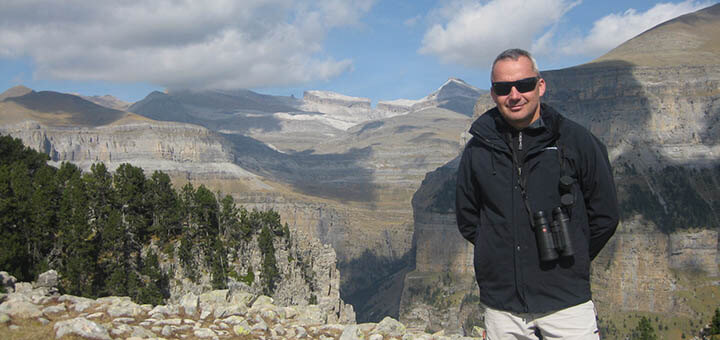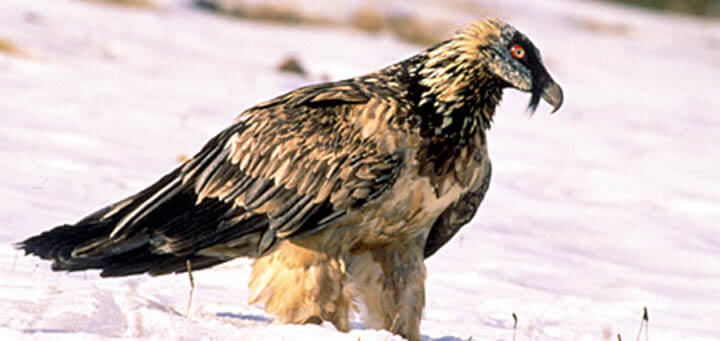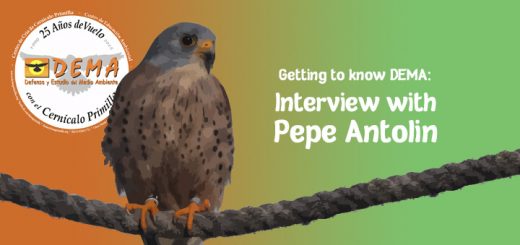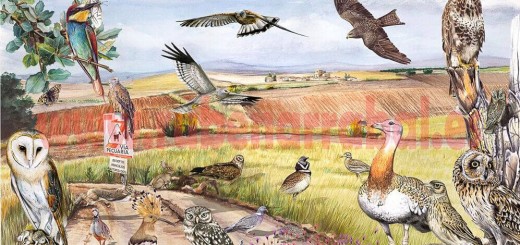InterIts Latin name, barbatus, refers to the beard that grows under his beak. Its yellow eyes with their characteristic reddish rings betray it, as well as the mask on its face and the hood on the top of its head. Its wedge-shaped tail and the orange colour of its mud-dyed plumage do the rest to identify it on flight. We are facing the king of necrophagous birds. It’s breathtaking to hear the characteristic sound of the bones falling into the ossuaries. The strength and dexterity they display to get food are also overwhelming. Among the problems the species faces are the low fertility, the reduced distribution and the limited ability for colonisation. But the Bearded Vulture has an ally. Since 1995, FCQ remains faithful to its work lines, highlighting the conservation, management, research, environmental education and rural development, particularly considering the knowledge of the species’ biology, without forgetting the awareness and communication tasks.
Among the current projects stand out the development of some actions from the Aragon Recovery Plan, carried out since 1994; the Antidote Programme against the use of poison, since 1998; the BORDA Project on rural development, and the more recent LIFE + Bearded Vulture Network in Picos de Europa, 2013-2018. All this thanks to the actions being developed for the sake of the species from their facilities in Huesca: Eco-museum Visitor Centre of Aínsa Castle and the Biological Station of Monte Perdido. We cannot forget the work performed in Benía de Onís (Asturias) by the Centre for Biodiversity and Sustainable Development: The Mountains of the Bearded Vulture. They are joined by the Centre for the Rescue and Breeding of the Bearded Vulture (CRIAH). Since 2008, the latter achieves the development of chicken and embryos of the species at the property La Alfranca in Zaragoza, which belongs to the Government of Aragon.

Juan Antonio Gil Gallus president of the Foundation for the Conservation of the Bearded Vulture – FCQ
From Birding 140 we want to support and spread the actions and projects developed by FCQ. For this purpose, we had an exclusive talk with their president, Juan Antonio Gil Gallús, who controls the conservation, tracking, research and management projects of the Bearded Vulture in the Pyrenees.
- Question: The SFP (Supplementary Feeding Points) are reliable and permanent feeding points throughout the Pyrenean-Cantabrian corridor. On the contrary, poison produces a great damage among carrion birds. FCQ has recently taken part of the annual meeting of the Antidote Programme held in Las Palmas de Gran Canaria. In this program, NGOs, the Administration and citizen collaboration play an important role in the fight against the scourge of poison. But which conclusions and which positive and negative questions can you draw from that meeting? To which extent do these actions benefit the species?
- Answer: One of the conclusions of the meeting was the need to address the revision of the National Anti-Poison Strategy, which accumulates a delay of 5 years. The different NGOs also highlighted the need and the importance of supporting crime investigation resources, like canine patrols for the detection of poisoned baits, as well as the implementation of toxicological analysis of the detected cases. These analysis are essential for the resolution of the cases, as are the recovery centres for wildlife species in the different autonomous communities in order to diagnose the cases of poisoning. The Antidote Programme appears in 1997, as a result of the concern of several entities about the catastrophic effect that the massive use of poison on the natural environment was causing on wildlife and, specially, on important endangered species. It comprises ten NGOs devoted to the conservation of the species which are most affected by the problem of poison: FCQ, SEO/BirdLife, Ecologists in Action, the Fund for the Protection of Wild Animals (FAPAS), the Spanish Society for the Conservation and Study of Mammals (SECEM), WWF/Spain, GREFA, the Brown Bear Foundation (FOA), the Black Vulture Conservation Foundation (BVCF) and the Wildlife Veterinarians Association (AVAFES Canary Islands). The union of all these organizations has served to boost some important initiatives in the fight against poison. Besides working to make this problem known to society, a Protocol for Action was developed for cases of fauna poisoning, which helped unify the criteria for carcase collection, and they took part in the drafting of the National Strategy Against the Illegal Use of Poisoned Baits in the natural environment, approved by the National Committee for the Protection of Nature in 2004.
- Question: The recent specimen releases in Picos de Europa as a part of the Proyecto LIFE + Bearded Vulture Network not only reinforce the expansion of the species, but they are also a resource to avoid its extinction. What is the current situation of the Bearded Vulture population in Spain? Is there a possibility for these territories to host future releases or enjoy the flight of these birds?
- Answer: In 2014, Spain had 128 Bearded Vulture reproductive units, which is the 65% of the EU’s population. At this moment there are two reintroduction projects in Spain: Andalusia and Cantabrian Mountains, where the efforts to consolidate new territories are focused, be it in Cazorla (Government of Andalusia) or Picos de Europa (FCQ, Government of Aragón, Cantabria, Asturias and Castile and León).
- Question: The last releases of the females Esperanza and Quebrantina have had major media coverage. Moreover, thanks to them, sightings have been increased in Picos de Europa since the release. But how do the released and wild specimens interact?
- Answer: From the date of their release, different interactions have been observed, not only among the specimens released in 2015, but also among other specimens released in previous years, like Biciele or Atilano.
- Question: Among the actions of the Centre for Bearded Vulture Breeding in Human Isolation (CRIAH) is the handling of a puppet simulating an adult in order to carry out the food input to the chicks. In this way human contact is avoid, thus eluding the imprinting phenomenon. But how is that moment? In which way is it carried out in order to transfer the knowledge and safety the chicks need? What is the percentage of success of this technique?
- Answer: This technique, also used with other endangered species like the California Condor, is properly working for the time being, due to the fact that all the specimens released until the date have normally developed in the natural environment. For instance, the Bearded Vulture María was adopted by three adults after its release. It was and unprecedented behaviour in Bearded Vultures until the date. The adoption of María from the three adults could only be possible if the behavioural and social pattern of the chicken was coherent with the social standard of the species.
- Question: We know that some of the specimens of the species have wing tags, and others are controlled via satellite. But what should our readers do if they are lucky enough to sight a specimen? What should they pay attention to in order to inform us about the sighting and where should they send that information?
- Answer: They can check the section “Seguimiento de ejemplares” (tracking of specimens) on our website, where they can find the data about each marked specimen and send the information through the online form.
- Question: Among all the possible ways for individuals and companies to collaborate with FCQ, there is the possibility of becoming a member, giving a donation, purchasing a product from the centres or sponsoring a Bearded Vulture. From our lack of knowledge, and in case someone considers it, what implies the sponsorship of one of this specimens?
- Answer: Any person sponsoring a Bearded Vulture is collaborating and contributing with the study of radiolabelled birds, which allows to annually improve the strategies for the conservation and survival of Bearded Vultures. The sponsorship includes the shipment of the following material: a personalized certificate, an exclusive stuffed Bearded Vulture, a quality picture of the chosen Bearded Vulture and the record sheet of the bird.
- Question: In the virtual shop we found on your site www.quebrantahuesos.org, the following books attracted our attention: On the Trail of the Bearded Vulture and Juvenile Dispersion of the Bearded Vulture in the Pyrenees. Can you talk a bit about them?
- Answer: The first one revises the state of preservation, distribution and population of the Bearded Vulture in the world. The one about juvenile dispersion exposes the results about dispersive patterns and behaviour of the species in the Aragonese Pyrenees.
- Question: We have the impression that, for this work not to be in vain, future generations need to learn how important it is for everyone to be able to enjoy these birds. For this reason, we support initiatives like the two routes you are developing in Huesca to observe the Bearded Vulture. One consists in the visit to the Eco-museum of the Pyrenean Fauna, and the other one is a guided route through the viewpoints of Revilla. What are they about?
- Answer: The guided visits for the observation of the Bearded Vulture are carried out only during summer season (July and August). They are targeted at all kinds of public (families, students, etc.), with the aim of making the species known on-site, as well as explaining the conservation programme developed by FCQ.
- Question: And, to conclude, how do you see the future of the species? Is there any future project you can talk about in advance?
- Answer: The situation of the species has substantially improved since we started. In 20 years it has practically doubled the reproductive population of 40 couples (1994) to more than 80 at the present time. We are currently developing the opportunity of carrying out a combined cross-border project with France for the launching of actions of rural development, conservation, ecotourism and awareness of the species.
With these lines we hope we have helped to spread the knowledge about the species and the actions and projects that are being developed by the Foundation for the Conservation of the Bearded Vulture. Furthermore, we give you our full support and we encourage our readers to collaborate to the extent possible. We greatly thank your president, Juan Antonio Gil, for his time and disposition for this interview. We hope to have shed light about the intricacies of the conservation of a species, which greatly benefits from the actions carried out by this foundation. We give full support to all those working or collaborating with FCQ, and we also hope we can take part in the spreading and popularization of their projects from now on, creating a new cooperation link in favour of this species.












